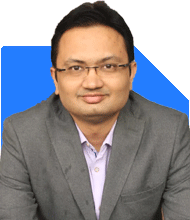Ramalingam Kalirajan |10906 Answers |Ask -Follow
Mutual Funds, Financial Planning Expert - Answered on May 21, 2024
He has an MBA in finance from the University of Madras and is a certified financial planner.
He is the director and chief financial planner at Holistic Investment, a Chennai-based firm that offers financial planning and wealth management advice.... more

Sir, i am 33yrs old and new to investment. I am planning to do SIP for long term next 15 to 20 years. What are the best MF for me to invest? Kindly help sir.
It's fantastic that you're starting your investment journey at 33. Investing in SIPs for the long term is a smart and disciplined approach.
Benefits of SIPs
Systematic Investment Plans (SIPs) help inculcate a habit of regular investing. They provide the advantage of rupee cost averaging and the power of compounding. Over 15 to 20 years, these benefits can significantly grow your wealth.
Importance of Actively Managed Funds
Actively managed funds have professional managers who make strategic decisions to maximize returns. Unlike index funds, which simply track market indices, actively managed funds adapt to market conditions. This can result in better performance and higher returns.
Disadvantages of Index Funds
Index funds have lower costs but lack flexibility. They often underperform during volatile market conditions. Actively managed funds, on the other hand, can adjust their strategies to navigate market fluctuations effectively.
Benefits of Investing Through a Certified Financial Planner
Investing through a Certified Financial Planner (CFP) provides expert guidance. They can help select the right funds based on your financial goals and risk tolerance. Regular funds invested through a CFP offer professional management and strategic oversight.
Diversifying Your Portfolio
Diversification is key to managing risk and optimizing returns. A well-diversified portfolio includes a mix of equity, debt, and balanced funds. This spread reduces the impact of market volatility on your overall investment.
Equity Funds for Growth
Equity funds invest in stocks and are suitable for long-term growth. They tend to offer higher returns compared to other funds but come with higher risk. Investing in a mix of large-cap, mid-cap, and small-cap funds can provide balanced growth.
Debt Funds for Stability
Debt funds invest in fixed-income securities like bonds and government securities. They offer stability and lower risk compared to equity funds. Including debt funds in your portfolio ensures a steady return and reduces overall risk.
Balanced Funds for Moderate Growth
Balanced funds, or hybrid funds, invest in both equity and debt. They provide a balance of growth and stability. These funds are suitable for investors looking for moderate returns with controlled risk.
Regular Portfolio Review
Regularly reviewing your portfolio is crucial. Market conditions and your financial goals can change over time. A CFP can help you rebalance your portfolio to ensure it remains aligned with your objectives.
Increasing SIP Contributions
As your income grows, consider increasing your SIP contributions. Even small incremental increases can significantly boost your investment corpus over time. The power of compounding will amplify these contributions, leading to substantial growth.
Avoiding Common Investment Pitfalls
Avoid making emotional investment decisions. Stick to your long-term plan and avoid reacting to short-term market fluctuations. Regular consultation with a CFP ensures you stay on track towards your financial goals.
Building an Emergency Fund
Maintain an emergency fund covering 6-12 months of expenses. This fund provides financial security and prevents the need to withdraw investments during emergencies.
Conclusion: A Balanced Approach
Your decision to invest in SIPs for the long term is wise. Focus on actively managed funds for better returns. Diversify your portfolio with a mix of equity, debt, and balanced funds. Regularly review and increase your SIP contributions, and maintain an emergency fund. Consulting with a CFP ensures professional guidance and helps you achieve your financial goals.
Best Regards,
K. Ramalingam, MBA, CFP,
Chief Financial Planner,
www.holisticinvestment.in
You may like to see similar questions and answers below
Omkeshwar Singh | Answer |Ask -Follow
Head, Rank MF - Answered on Dec 02, 2021
Nikunj Saraf | Answer |Ask -Follow
Mutual Funds Expert - Answered on Nov 29, 2022
Sunil Lala | Answer |Ask -Follow
Financial Planner - Answered on Mar 31, 2023
Tejas Chokshi | Answer |Ask -Follow
Tax Expert - Answered on Jun 14, 2023
Ramalingam Kalirajan |10906 Answers |Ask -Follow
Mutual Funds, Financial Planning Expert - Answered on Oct 24, 2024
Ramalingam Kalirajan |10906 Answers |Ask -Follow
Mutual Funds, Financial Planning Expert - Answered on Dec 19, 2025
Nayagam P P |10859 Answers |Ask -Follow
Career Counsellor - Answered on Dec 19, 2025
Ramalingam Kalirajan |10906 Answers |Ask -Follow
Mutual Funds, Financial Planning Expert - Answered on Dec 19, 2025
Ramalingam Kalirajan |10906 Answers |Ask -Follow
Mutual Funds, Financial Planning Expert - Answered on Dec 19, 2025
Ramalingam Kalirajan |10906 Answers |Ask -Follow
Mutual Funds, Financial Planning Expert - Answered on Dec 19, 2025
Radheshyam Zanwar |6751 Answers |Ask -Follow
MHT-CET, IIT-JEE, NEET-UG Expert - Answered on Dec 19, 2025
Radheshyam Zanwar |6751 Answers |Ask -Follow
MHT-CET, IIT-JEE, NEET-UG Expert - Answered on Dec 19, 2025
Samraat Jadhav |2514 Answers |Ask -Follow
Stock Market Expert - Answered on Dec 18, 2025
Reetika Sharma |432 Answers |Ask -Follow
Financial Planner, MF and Insurance Expert - Answered on Dec 18, 2025
Reetika Sharma |432 Answers |Ask -Follow
Financial Planner, MF and Insurance Expert - Answered on Dec 18, 2025




























